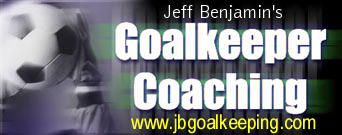
|
"Outstanding keeper instruction. This is a must for goalkeepers and coaches." —Ottawa Internationals S.C. web site, Ottawa, Canada |

|

|
Top |
Goalkeeping Tips, Tidbits and Random Thoughts
An athlete talking to themsleves during competition is hardly a new phenomenon.... The talk does not have to be vocal. By merely thinking you are talking to yourself and sending a message.
-- Tony DiCicco, Goalkeeper Soccer Training Manual
If you have a question, comment or rebuttal you'd like to see addressed here, send me email. I will post your mail to the blog at my discretion unless you specify otherwise.
What are you communicating?
Last winter I was at a college showcase tournament. As I watched a particularly graceful, tall girl dribble the ball down the field, it suddenly struck me: dribbling a soccer ball is a quite unnatural movement. It is not like running, or walking, at all. It's more like dancing. That insight goes a long way, for me, to explaining why it is very difficult to become an excellent soccer player unless you pick up the basic skills at an early age.When training field players as well as goalkeepers, we use the words "rhythm" and "tempo" a lot. I'll ask my players to "dance" with the ball, and explain the reason that Brazil are known as the "Samba Kings". There is a particular movement and fluidity to a good soccer player; light and smooth and quick and in control. Even a goalkeeper stretched out at full length to make a save is demonstrating a particular dance: the footwork, the acrobatics, the gentle fall. A goalkeeper can control the pace of a game: are they quick and jerky or calm and controlled, slow and deliberate or fast and decisive?
Today I came across an article at Gladwell.com (Malcolm Gladwell is the author of Blink and The Tipping Point): What the Dog Saw. It's an article about Cesar Millan, the "dog whisperer" who can solve even the worst cases of canine misbehavior. But much of the article is not about what Milan says or does, but how he moves. So these passages particularly caught my eye:
Cesar is fluid. "He's beautifully organized intra-physically," Karen Bradley, who heads the graduate dance program at the University of Maryland, said when she first saw tapes of Cesar in action. "That lower-unit organization—I wonder whether he was a soccer player."
...
Combinations of posture and gesture are called phrasing, and the great communicators are those who match their phrasing with their communicative intentions—who understand, for instance, that emphasis requires them to be bound and explosive. To Bradley, Cesar had beautiful phrasing.
When you play, what are you communicating? Not just verbally, we all know about verbal communication, but non-verbally?
Labels: Tactics
Keep those field skills sharp
Another reason to keep those field skills sharp: Reina plays in midfield as Liverpool defeated. By this story, he gave a good account of himself as well.Labels: Matchday observations
Solo interview
US Women's National Team goalkeeper Hope Solo pointed out in a US Soccer interview how much of a mental game goalkeeping is. You might be athletic and a good shot stopper, but that doesn't make a good goalkeeper. To watch, go to US Soccer Sights & Sounds, 2005 WNT features, select "Hope Solo on the 'Keepers Union" and press play.Labels: Goalkeeping News and Analysis
Why top goalkeepers tend to be fatty folk.
To which a KeeperZone poster replied: "Excellent news! Just cancelled my gym membership and ordered a pizza! Cant think of a better way to train if Im honest!!"
To which a KeeperZone poster replied: "Excellent news! Just cancelled my gym membership and ordered a pizza! Cant think of a better way to train if Im honest!!"
Labels: Goalkeeping News and Analysis, Training
Get into the game
IMHO one of the reasons keepers sometimes trail field players in tactical development is that goalkeepers simply aren't put into enough game-like situations during the team's practice. Sure, there's a lot of individual technical work that needs to be done, but to become a true goalkeeper you need to learn the decision-making: stay or come out, timing on breakaways and crosses, communication, etc.My ideal training is to work the goalkeepers separately at the start on individual technique that is related to what the field players are doing, and then bring them all together for the final part of practice for related games. For example, the keepers might work on high balls and crosses while the team start in on crossing and finishing, then we play crossing games to end practice.
A couple good ideas are an activity called "Team Trains the Keeper", and simply allowing a keeper to participate in a keepaway game as a keeper and use hands. Here are a few others:
"Shaggers": one of the most popular games at keeper camp, and strikers love it too (plus it gets those field players to see what it's like in goal for a bit!). Mark two lines, 6 and 12 yards out from goal. Two teams in lines 18 yards out, coach with balls at post. Team A keeper in goal. Coach serves ball on ground to first Team B player who must shoot first time from outside 12 yards. If B scores, coach serves a second ball in the air that B must volley from outside 6 yards. If B scores both goals, A keeper is out; if B fails to score either ball, the turn is over and... B immediately becomes the new keeper and coach serves a ball on the ground to next Team A player in line. Repeat the process. If a keeper is not scored on twice, they go back to the end of their team's shooting line. Continue until one team is eliminated.
"Make the Save": A keepaway game with one (or more) keepers on each team. A team tries to play the ball to their keeper, and the team receives a point if their keeper can make these saves in order: a rolling ball pickup, a collapsed dive, a high ball save in the air.
"Keeper Targets": Any small-sided game can use goalkeepers as targets. The objective is not to kick the ball past the keeper, but kick the ball to the keeper to score a point. The keeper then restarts the play immediately to the other team, and can act as a backpass option for that team as well.
"Pressure Cooker": Small field, about 30x40 yards with two full-size goals and keepers. Play 3v3 or 4v4, and encourage shots from anywhere.
Many of my training sessions are based on having a group, and the activities towards the end often utilize field players as well as keepers, so take a look there for ideas too.
Labels: Training